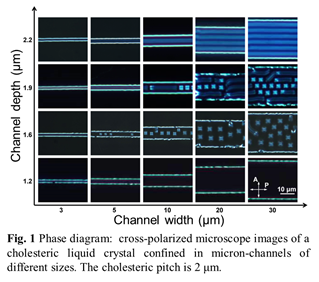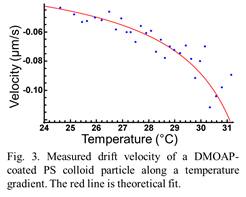Reports: ND753018-ND7: Experimental and Numerical Studies of Liquid Crystal Defects in Confined Geometries
Qi-Huo Wei, PhD, Kent State University
The objective of this The NDI grant from PRF provides a significant support
for the PI to extend his research into new areas in liquid crystals and to establish
close collaborations with expert colleagues in liquid crystals. Direct support
of this grant has benefited four graduate students and generated research
results for three manuscripts.
 (1) LC droplets on Chemically Patterned
Substrates: We have developed micro-contact printing process to pattern
self-assembled monolayers and a drag-drop process to form liquid crystal
droplets on these molecular patterns. To understand the defects textures observed
in these patterned nematic liquid crystal droplets, we have developed
Monte-Carlo simulation algorithms and our simulation results show that the
domain structures of the patterned self-assembled monolayers have significant
impacts on the the defects inside the droplets. When the domain sizes are
small, only one single defect are normally observed, and the situation is
similar to planar degenerate anchoring. When the domain size is increased, the
defect structures are complex and highly sensitive to the domain structures.
(1) LC droplets on Chemically Patterned
Substrates: We have developed micro-contact printing process to pattern
self-assembled monolayers and a drag-drop process to form liquid crystal
droplets on these molecular patterns. To understand the defects textures observed
in these patterned nematic liquid crystal droplets, we have developed
Monte-Carlo simulation algorithms and our simulation results show that the
domain structures of the patterned self-assembled monolayers have significant
impacts on the the defects inside the droplets. When the domain sizes are
small, only one single defect are normally observed, and the situation is
similar to planar degenerate anchoring. When the domain size is increased, the
defect structures are complex and highly sensitive to the domain structures.  To gain insights into these defect structures, we
carried out simulation studies using a finite difference relaxation technique.
Our model is based on the Frank free energy expressed in terms of the nematic
order tensor. Starting from a discrete representation of the director on a
cubic lattice mesh spanning our model geometry, we relax the director at each
site. By implementing this algorithm in the CUDA programming language on a
GPU-equipped computer, we have achieved very impressive computational
performance with a speed-up of a factor of 45 vs execution on a single
processor. To study the dependence of defect structures on temperature, we
considered the temperature dependence of the Frank elastic constants and the
cholesteric pitch. This approach allowed modelling evolution of defect
structures as a function of both geometry and temperature. An exemplary skymion
structure simulated in the microchannels is shown Fig. 2.
To gain insights into these defect structures, we
carried out simulation studies using a finite difference relaxation technique.
Our model is based on the Frank free energy expressed in terms of the nematic
order tensor. Starting from a discrete representation of the director on a
cubic lattice mesh spanning our model geometry, we relax the director at each
site. By implementing this algorithm in the CUDA programming language on a
GPU-equipped computer, we have achieved very impressive computational
performance with a speed-up of a factor of 45 vs execution on a single
processor. To study the dependence of defect structures on temperature, we
considered the temperature dependence of the Frank elastic constants and the
cholesteric pitch. This approach allowed modelling evolution of defect
structures as a function of both geometry and temperature. An exemplary skymion
structure simulated in the microchannels is shown Fig. 2.  A
A![]()
![]()











